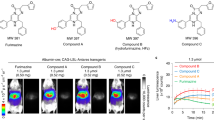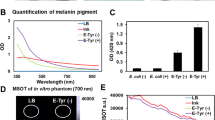Abstract
We describe a protocol for imaging bacterial luciferase (Lux)-expressing bacteria in small living animals. In this protocol, light emitted by Lux-expressing bacteria is detected and monitored by a cooled charge-coupled device detector. When these bacteria are administered to animals, it provides a potentially valuable approach to generate sensitive whole-body images with extremely low background. This imaging technology should enable the real-time monitoring of bacterial migration into both primary and metastatic tumors in several different mouse tumor models at a strong quantification power.
This is a preview of subscription content, access via your institution
Access options
Subscribe to this journal
Receive 12 print issues and online access
$259.00 per year
only $21.58 per issue
Buy this article
- Purchase on Springer Link
- Instant access to full article PDF
Prices may be subject to local taxes which are calculated during checkout




Similar content being viewed by others
References
Agrawal, N. et al. Bacteriolytic therapy can generate a potent immune response against experimental tumors. Proc. Natl. Acad. Sci. USA 101, 15172–15177 (2004).
Yazawa, K., Fujimori, M., Amano, J., Kano, Y. & Taniguchi, S. Bifidobacterium longum as a delivery system for cancer gene therapy: selective localization and growth in hypoxic tumors. Cancer Gene Ther. 7, 269–274 (2000).
Dang, L.H., Bettegowda, C., Huso, D.L., Kinzler, K.W. & Vogelstein, B. Combination bacteriolytic therapy for the treatment of experimental tumors. Proc. Natl. Acad. Sci. USA 98, 15155–15160 (2001).
Zhao, M. et al. Targeted therapy with a Salmonella typhimurium leucine–arginine auxotroph cures orthotopic human breast tumors in nude mice. Cancer Res. 66, 7647–7652 (2006).
Low, K.B. et al. Lipid A mutant Salmonella with suppressed virulence and TNFalpha induction retain tumor-targeting in vivo. Nat. Biotechnol. 17, 37–41 (1999).
Pawelek, J.M., Low, K.B. & Bermudes, D. Bacteria as tumour-targeting vectors. Lancet Oncol. 4, 548–556 (2003).
Zhao, M. et al. Monotherapy with a tumor-targeting mutant of Salmonella typhimurium cures orthotopic metastatic mouse models of human prostate cancer. Proc. Natl. Acad. Sci. USA 104, 10170–10174 (2007).
Hoffman, R.M. & Zhao, M. Whole-body imaging of bacterial infection and antibiotic response. Nat. Protoc. 1, 2988–2994 (2006).
Min, J.J. et al. Noninvasive real-time imaging of tumors and metastases using tumor-targeting light-emitting Escherichia coli. Mol. Imaging Biol. 10, 54–61 (2008).
Yu, Y.A. et al. Visualization of tumors and metastases in live animals with bacteria and vaccinia virus encoding light-emitting proteins. Nat. Biotechnol. 22, 313–320 (2004).
Zhao, M. et al. Tumor-targeting bacterial therapy with amino acid auxotrophs of GFP-expressing Salmonella typhimurium. Proc. Natl. Acad. Sci. USA 102, 755–760 (2005).
Blattner, F.R. et al. The complete genome sequence of Escherichia coli K-12. Science 277, 1453–1474 (1997).
Hoffman, R.M. & Yang, M. Whole-body imaging with fluorescent proteins. Nat. Protoc. 1, 1429–1438 (2006).
Curtiss, R. III, Kelly, S.M., Gulig, P.A. & Nakayama, K. Stable recombinant avirulent Salmonella vaccine strains. Adv. Exp. Med. Biol. 251, 33–47 (1989).
Datsenko, K.A. & Wanner, B.L. One-step inactivation of chromosomal genes in Escherichia coli K-12 using PCR products. Proc. Natl. Acad. Sci. USA 97, 6640–6645 (2000).
Lorenz, M.G. & Wackernagel, W. Bacterial gene transfer by natural genetic transformation in the environment. Microbiol. Rev. 58, 563–602 (1994).
Murphy, K.C. Use of bacteriophage lambda recombination functions to promote gene replacement in Escherichia coli. J. Bacteriol. 180, 2063–2071 (1998).
Cherepanov, P.P. & Wackernagel, W. Gene disruption in Escherichia coli: TcR and KmR cassettes with the option of Flp-catalyzed excision of the antibiotic-resistance determinant. Gene 158, 9–14 (1995).
Lee, C.Y., Szittner, R.B. & Meighen, E.A. The lux genes of the luminous bacterial symbiont, Photobacterium leiognathi, of the ponyfish. Nucleotide sequence, difference in gene organization, and high expression in mutant Escherichia coli. Eur. J. Biochem. 201, 161–167 (1991).
Acknowledgements
We thank Dr. Young-Soon Seo for the technical assistance. This work was supported by a grant from the National R&D Program for Cancer Control (0620330-1), Ministry of Health & Welfare, Republic of Korea, and partially by the Korea Science and Engineering Foundation (KOSEF) grant funded by the Ministry of Science and Technology (MOST), Republic of Korea, through its National Nuclear Technology Program (M20702010003-07N0201-00300). H.E.C. was supported by the KOSEF grant funded by the Korea government (MOST) (no. 2007-04213) and Y.H. was supported by Grant No. RTI05-01-01 from the Regional Technology Innovation Program of the Ministry of Commerce, Industry and Energy.
Author information
Authors and Affiliations
Corresponding author
Rights and permissions
About this article
Cite this article
Min, JJ., Nguyen, V., Kim, HJ. et al. Quantitative bioluminescence imaging of tumor-targeting bacteria in living animals. Nat Protoc 3, 629–636 (2008). https://doi.org/10.1038/nprot.2008.32
Published:
Issue Date:
DOI: https://doi.org/10.1038/nprot.2008.32
This article is cited by
-
Engineered live bacteria as disease detection and diagnosis tools
Journal of Biological Engineering (2023)
-
In vivo bioluminescence imaging of natural bacteria within deep tissues via ATP-binding cassette sugar transporter
Nature Communications (2023)
-
Bacterial therapies at the interface of synthetic biology and nanomedicine
Nature Reviews Bioengineering (2023)
-
Del-1 enhances therapeutic efficacy of bacterial cancer immunotherapy by blocking recruitment of tumor-infiltrating neutrophils
Clinical and Translational Oncology (2022)
-
Bacterial bioluminescence assay for bioanalysis and bioimaging
Analytical and Bioanalytical Chemistry (2022)
Comments
By submitting a comment you agree to abide by our Terms and Community Guidelines. If you find something abusive or that does not comply with our terms or guidelines please flag it as inappropriate.



